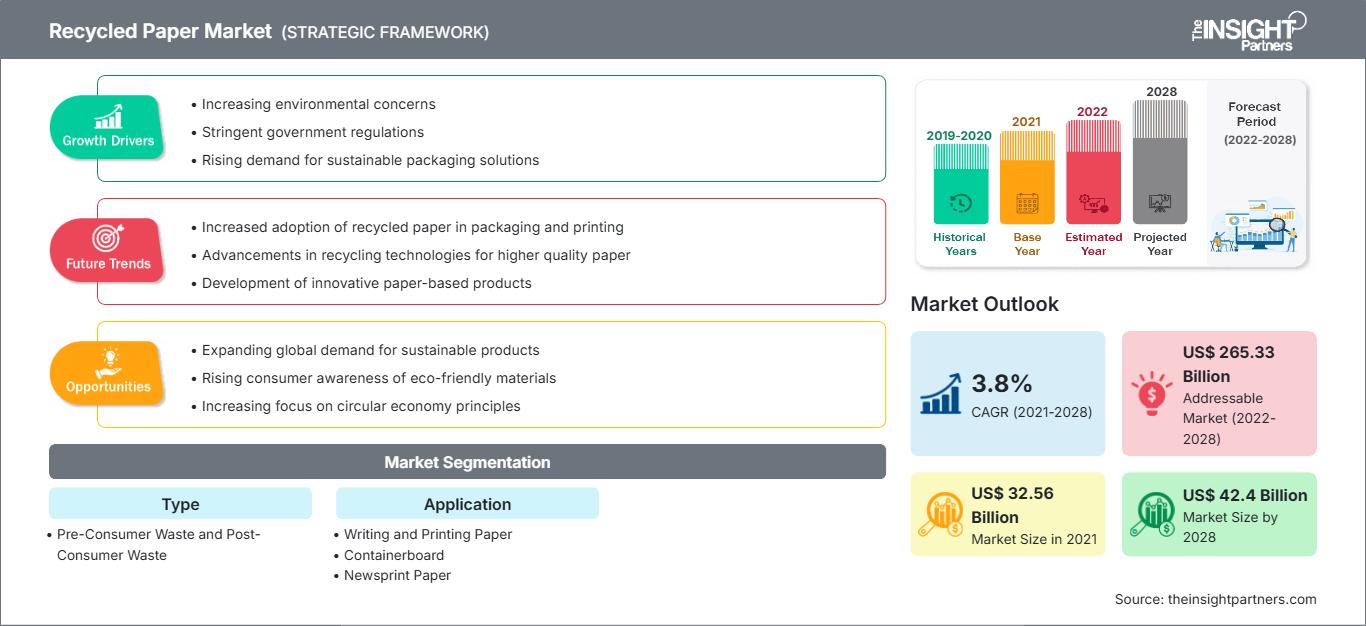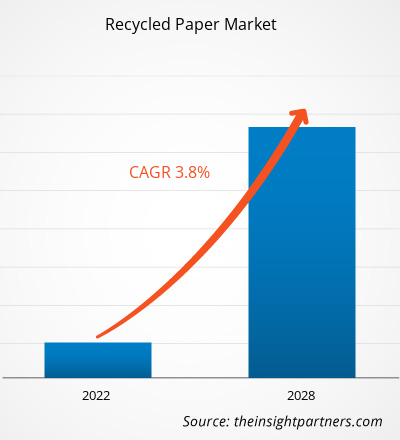Si prevede che il mercato della carta riciclata crescerà da 32.558,44 milioni di dollari nel 2021 a 42.395,79 milioni di dollari entro il 2028; si stima una crescita a un CAGR del 3,8% dal 2021 al 2028.
Si registra un aumento significativo della domanda di carta riciclata dovuto alle crescenti iniziative dei governi di diverse nazioni per incoraggiare il riciclaggio della carta da macero. La carta riciclata è limitata alla carta utilizzata in applicazioni industriali, ma include anche la carta da macero domestica come giornali, riviste e carta da imballaggio. La generazione di rifiuti di carta da queste fonti è molto elevata e questi rifiuti devono essere riciclati anziché essere smaltiti o bruciati. Con l'attuazione di normative governative e la formazione di nuove associazioni legate alla carta riciclata, si stima che il mercato della carta riciclata si espanderà rapidamente nei prossimi anni.
Si prevede che il mercato della carta riciclata nell'area Asia-Pacifico crescerà al CAGR più elevato durante il periodo di previsione. Molti paesi dell'Asia-Pacifico, tra cui Australia, Cina, India e Giappone, vantano numerose industrie manifatturiere, come siderurgia, estrazione mineraria e metallurgia, petrolchimica, petrolio e gas, alimenti e bevande e tessile. Con la rapida crescita economica e l'urbanizzazione, la produzione e la gestione dei rifiuti stanno diventando importanti problemi sociali e ambientali in Asia. Ogni paese asiatico ha misure specifiche per la gestione dei rifiuti solidi e politiche sul ciclo dei materiali. La discarica è l'opzione di smaltimento più comune adottata in molti paesi asiatici, poiché è poco costosa. Molti paesi di questa regione hanno recentemente introdotto leggi sui rifiuti solidi urbani (RSU). Secondo la Banca Mondiale, le aree urbane dell'Asia-Pacifico producono circa 760.000 tonnellate di RSU al giorno e si stima che questa cifra aumenterà a 1,8 milioni di tonnellate entro il 2025. La domanda potenziale di prodotti come carta bianca e colorata, cartone, giornali, riviste e opuscoli, carta triturata e documenti stampati da parte di vari settori dell'Asia-Pacifico è in aumento. In questo modo si accelera la richiesta di carta riciclata nella regione Asia-Pacifico, stimolando la crescita del mercato.
Personalizza questo rapporto in base alle tue esigenze
Potrai personalizzare gratuitamente qualsiasi rapporto, comprese parti di questo rapporto, o analisi a livello di paese, pacchetto dati Excel, oltre a usufruire di grandi offerte e sconti per start-up e università
Mercato della carta riciclata: Approfondimenti strategici

-
Ottieni le principali tendenze chiave del mercato di questo rapporto.Questo campione GRATUITO includerà l'analisi dei dati, che vanno dalle tendenze di mercato alle stime e alle previsioni.
Impatto della pandemia di COVID-19 sul mercato della carta riciclata
La pandemia di COVID-19 ha drasticamente alterato lo stato del settore chimico e dei materiali e ha avuto un impatto negativo sulla crescita del mercato della carta riciclata. L'attuazione di misure per contrastare la diffusione del virus ha aggravato la situazione e ha avuto un impatto sulla crescita di diversi settori industriali. L'improvvisa distorsione ha avuto ripercussioni sull'efficienza operativa di settori come l'automotive e il packaging, con conseguenti interruzioni nelle catene del valore attribuibili alla chiusura improvvisa dei confini nazionali e internazionali. Il significativo calo della crescita di diversi settori industriali ha avuto un impatto significativo sulla domanda di carta riciclata nel mercato globale. A causa della pandemia di COVID-19, il mercato ha avuto un impatto negativo sulla sua produzione a causa della chiusura di fabbriche in tutto il mondo. Si prevede che questa pandemia avrà un impatto moderato sul mercato della carta riciclata e che il mercato si riprenderà nei prossimi due o tre trimestri.
Approfondimenti di mercato
Regolamentazioni governative rigorose per la gestione dei rifiuti
La crescente consapevolezza dell'impatto ambientale dell'accumulo di rifiuti e la mancata gestione degli stessi sono state tra le principali ragioni che hanno spinto diversi governi in tutto il mondo a imporre normative sulla gestione dei rifiuti. L'industria del riciclo della carta si è espansa in molti paesi come Stati Uniti, Canada, India, Cina, Giappone e Germania. I governi di diverse nazioni stanno implementando normative per incoraggiare il riciclo della carta da macero. Numerose associazioni come l'American Forest & Paper Association (AF&PA), l'Independent Waste Paper Processors Association (IWPPA), la Confederation of Paper Industries (CPI) e l'European Recovered Paper Association (ERPA) incoraggiano la pratica del riciclo della carta. Tali associazioni stanno supportando la crescita del mercato della carta riciclata.
Approfondimenti sulla tipologia
In base alla tipologia, il mercato della carta riciclata è segmentato in rifiuti pre-consumo e rifiuti post-consumo. Il segmento dei rifiuti pre-consumo ha rappresentato una quota di mercato maggiore nel 2020 e si prevede che crescerà più rapidamente durante il periodo di previsione. Il riciclo pre-consumo consiste nel recupero dei materiali di scarto creati durante la produzione o la distribuzione dei prodotti prima della consegna al consumatore. I materiali riciclati pre-consumo possono essere scomposti e rigenerati in materiali simili o diversi. Nel caso della carta, i rifiuti pre-consumo si riferiscono agli scarti e ai ritagli che sono stati tagliati e scartati durante il processo di taglio. Pertanto, si prevede che il segmento dei rifiuti pre-consumo offrirà una potenziale opportunità di crescita nei prossimi anni.
Approfondimenti sulle applicazioni
In base all'applicazione, il mercato della carta riciclata è segmentato in carta per scrittura e stampa, cartone per imballaggio, carta da giornale, carta tissue e altre. Si prevede che il segmento del cartone ondulato crescerà grazie alla maggiore produzione, con oltre 100 milioni di tonnellate prodotte ogni anno. La crescita del segmento della carta da stampa e da scrittura è attribuibile alle ampie applicazioni in uffici, abitazioni, scuole ed enti governativi. Si prevede inoltre che il segmento della carta da giornale aumenterà la sua quota di mercato grazie al suo utilizzo nella stampa di quotidiani e altre pubblicazioni.
I principali attori che operano nel mercato della carta riciclata includono Cascades Recovery+; Global Waste Recyclers Ltd; Hanna Paper; Heinzel Holding GmbH; Republic Services, Inc.; International Paper; Perlen Papier; Sonoco Products Company; ST PAPER RESOURCES PTE LTD; e WASCO. Le aziende chiave adottano strategie come fusioni e acquisizioni e ricerca e sviluppo per espandere la propria base clienti e acquisire una quota significativa nel mercato globale, consentendo loro di mantenere il proprio marchio a livello globale.
Mercato della carta riciclata
Le tendenze regionali e i fattori che influenzano il mercato della carta riciclata durante il periodo di previsione sono stati ampiamente spiegati dagli analisti di The Insight Partners. Questa sezione analizza anche i segmenti e la distribuzione geografica del mercato della carta riciclata in Nord America, Europa, Asia-Pacifico, Medio Oriente e Africa, America Meridionale e Centrale.
Ambito del rapporto sul mercato della carta riciclata
| Attributo del rapporto | Dettagli |
|---|---|
| Dimensioni del mercato in 2021 | US$ 32.56 Billion |
| Dimensioni del mercato per 2028 | US$ 42.4 Billion |
| CAGR globale (2021 - 2028) | 3.8% |
| Dati storici | 2019-2020 |
| Periodo di previsione | 2022-2028 |
| Segmenti coperti |
By Tipologia
|
| Regioni e paesi coperti |
Nord America
|
| Leader di mercato e profili aziendali chiave |
|
Densità degli operatori del mercato della carta riciclata: comprendere il suo impatto sulle dinamiche aziendali
Il mercato della carta riciclata è in rapida crescita, trainato dalla crescente domanda da parte degli utenti finali, dovuta a fattori quali l'evoluzione delle preferenze dei consumatori, i progressi tecnologici e una maggiore consapevolezza dei vantaggi del prodotto. Con l'aumento della domanda, le aziende stanno ampliando la propria offerta, innovando per soddisfare le esigenze dei consumatori e sfruttando le tendenze emergenti, alimentando ulteriormente la crescita del mercato.

- Ottieni il Mercato della carta riciclata Panoramica dei principali attori chiave
In evidenza nel rapporto
- Tendenze progressive del settore nel mercato della carta riciclata per aiutare gli operatori a sviluppare strategie efficaci a lungo termine
- Strategie di crescita aziendale adottate dai mercati sviluppati e in via di sviluppo
- Analisi quantitativa del mercato della carta riciclata dal 2018 al 2028
- Stima della domanda globale di carta riciclata
- Analisi PEST per illustrare l'efficacia di acquirenti e fornitori che operano nel settore
- Sviluppi recenti per comprendere lo scenario competitivo del mercato
- Tendenze e prospettive di mercato, nonché fattori che guidano e frenano la crescita del mercato della carta riciclata
- Assistenza nel processo decisionale evidenziando le strategie di mercato che sostengono l'interesse commerciale, portando alla crescita del mercato
- Le dimensioni del mercato della carta riciclata in vari nodi
- Panoramica dettagliata e segmentazione del mercato, nonché le dinamiche del settore della carta riciclata
- Dimensioni del mercato della carta riciclata in varie regioni con promettenti opportunità di crescita
Mercato della carta riciclata - per tipo
- Rifiuti pre-consumo
- Rifiuti post-consumo
Mercato della carta riciclata - per applicazione
- Carta da stampa
- Cartone per imballaggio
- Carta da giornale
- Carta velina
- Altro
Profili aziendali
- Cascades Recovery+
- Global Waste Recyclers Ltd.
- Hanna Paper
- Heinzel Holding GmbH
- Republic Services, Inc.
- International Paper
- Perlen Papier
- Sonoco Products Company
- ST PAPER RESOURCES PTE LTD
- WASCO
- Analisi storica (2 anni), anno base, previsione (7 anni) con CAGR
- Analisi PEST e SWOT
- Valore/volume delle dimensioni del mercato - Globale, Regionale, Nazionale
- Industria e panorama competitivo
- Set di dati Excel
Report recenti
Rapporti correlati
Testimonianze
Motivo dell'acquisto
- Processo decisionale informato
- Comprensione delle dinamiche di mercato
- Analisi competitiva
- Analisi dei clienti
- Previsioni di mercato
- Mitigazione del rischio
- Pianificazione strategica
- Giustificazione degli investimenti
- Identificazione dei mercati emergenti
- Miglioramento delle strategie di marketing
- Aumento dell'efficienza operativa
- Allineamento alle tendenze normative






















 Ottieni un campione gratuito per - Mercato della carta riciclata
Ottieni un campione gratuito per - Mercato della carta riciclata